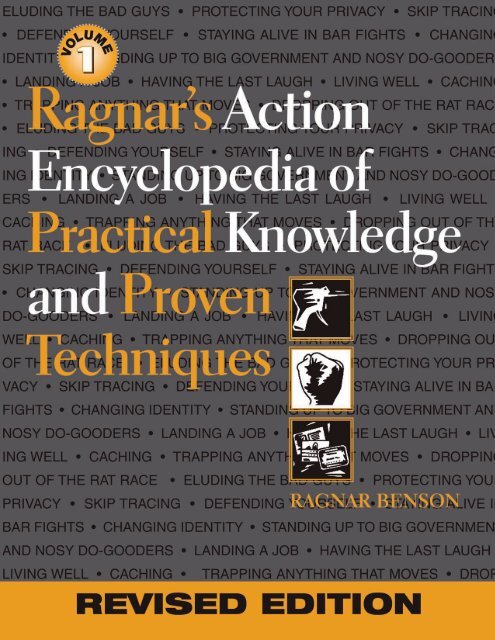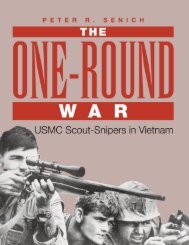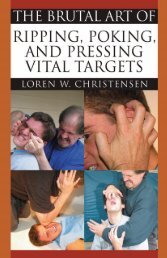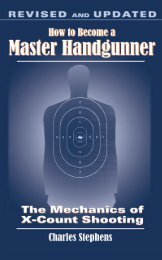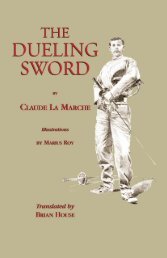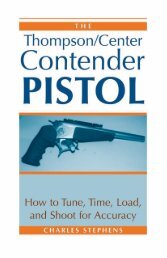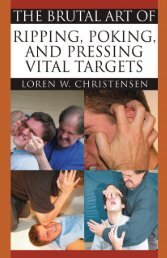Ragnar's Action Encyclopedia of Practical ... - Paladin Press
Ragnar's Action Encyclopedia of Practical ... - Paladin Press
Ragnar's Action Encyclopedia of Practical ... - Paladin Press
You also want an ePaper? Increase the reach of your titles
YUMPU automatically turns print PDFs into web optimized ePapers that Google loves.
Warning<br />
Some <strong>of</strong> the activities discussed in this book are dangerous and should not be attempted by those who<br />
are not trained in the correct procedures. Other items may be regulated by federal, state, or municipal<br />
agencies. It is up to the reader to research appropriate ordinances and ensure that he is in compliance with<br />
all applicable laws. Failure to do so could result in heavy fines or imprisonment. Neither the author nor<br />
publisher accepts any responsibility for the use or misuse <strong>of</strong> information contained in this book. It is<br />
presented for academic study only.
Contents<br />
Chapter 1: Improvised Firearms ...................... 1<br />
Chapter 2: Silencers......................................... 7<br />
Chapter 3: Assault Shotguns ......................... 13<br />
Chapter 4: Submachine Guns ........................ 19<br />
Chapter 5: Switchblade Knives...................... 23<br />
Chapter 6: Bulletpro<strong>of</strong> Vests.......................... 27<br />
Chapter 7: Night Vision Devices................... 33<br />
Chapter 8: AR-15 Models and Development 39<br />
Chapter 9: Personalizing the AR-15.............. 45<br />
Chapter 10: AK-47s....................................... 53<br />
Chapter 11: SKS Carbines............................. 59<br />
Chapter 12: The AR-15 Pistol ....................... 63<br />
Chaoter 13: The Mini-14 ............................... 67<br />
Chapter 14: AR-7: Half Pistol, Half Rifle ..... 73<br />
Chapter 15: The Mighty Spud Gun ............... 79<br />
Chapter 16: A Great .22 Handgun................. 83<br />
Chapter 17: The Grendel P-30....................... 89<br />
Chapter 18: The .22 Rifle .............................. 93<br />
Chapter 19: Crossbows.................................. 97<br />
Chapter 20: Blowguns ................................. 103<br />
Chapter 21: Surreptitious Weapons ............. 107<br />
Chapter 22: The Future Infantry Weapon.... 111<br />
Chapter 23: Combat Shotguns..................... 119<br />
Chapter 24: Shotgun Deployment in Combat 125<br />
Chapter 25: Combat Handguns ................... 131<br />
Chapter 26: Knife Fighting.......................... 137<br />
Chapter 27: Balisong Knives....................... 143<br />
Chapter 28: Mantrapping............................. 149<br />
Chapter 29: Hostage Negotiations............... 155<br />
Chapter 30: Electronic Perimeter Defense .. 161<br />
Chapter 31: Taps and Bugs.......................... 167<br />
Chapter 32: Lock Picking............................ 173<br />
Chapter 33: Interrogation............................. 177<br />
Chapter 34: Lie Detectors............................ 183<br />
Chapter 35: Drunk-Driving Charges ........... 189<br />
Chapter 36: Caching .................................... 193<br />
Chapter 37: Snipers ..................................... 199<br />
Chapter 38: Diguises ................................... 205<br />
v
RAGNAR’S ACTION ENCYCLOPEDIA OF PRACTICAL KNOWLEDGE AND PROVEN TECHNIQUES<br />
Chapter 39: TV Scramblers ......................... 209<br />
Chapter 40: Clandestine Radios .................. 215<br />
Chapter 41: Medical Care............................ 221<br />
Chapter 42: Auto Pursuit & Evasion ........... 229<br />
Chapter 43: Radar Detectors and Jammers.. 233<br />
Chapter 44: Hiding ...................................... 237<br />
Chapter 45: Skip Tracing............................. 243<br />
Chapter 46: New ID..................................... 249<br />
Chapter 47: Bar Fighting ............................. 255<br />
Chapter 48: Hostage Rescue Units .............. 261<br />
Chapter 49: <strong>Action</strong> Careers ......................... 267<br />
Chapter 50: Stuntman .................................. 275<br />
Chapter 51: Bounty Hunter ......................... 279<br />
Chapter 52: Martial Arts.............................. 279<br />
Chapter 53: Credit Bureaus ......................... 291<br />
Chapter 54: Trapping................................... 295<br />
Chapter 55: Survival Skills.......................... 301<br />
Chapter 56: Defending Your Retreat ........... 307<br />
Chapter 57: Eating Cheap............................ 313<br />
Chapter 58: Homemade Booze.................... 319<br />
Chapter 59: Survival Poaching .................... 325<br />
Chapter 60: Revenge.................................... 331<br />
Conclusion................................................... 335<br />
vi
CHAPTER<br />
Improvised Firearms<br />
1<br />
Our own U.S. government has<br />
seemingly done more work on<br />
improvised firearms than any<br />
other entity, public or private.<br />
It is therefore appropriate to<br />
go to them for literature on<br />
the subject.<br />
During World War II, a great many simple,<br />
essentially improvised firearms were designed,<br />
manufactured, purchased, and distributed by Uncle<br />
Sugar in Europe, especially Yugoslavia, and the<br />
Philippines. In addition, Office <strong>of</strong> Strategic<br />
Services (OSS) personnel were given a great deal<br />
<strong>of</strong> training in assembling improvised firearms.<br />
Huge numbers <strong>of</strong> printed instructions on firearms<br />
improvisation were also distributed to partisans<br />
and other resistance groups.<br />
Partly as a result <strong>of</strong> this vast experience, several<br />
mostly philosophical considerations permeate any<br />
discussion on homebuilt firearms. These involve the<br />
following facts:<br />
1. Improvised firearms should always be viewed as<br />
temporary expedients with which you could<br />
obtain a real, workable military-type firearm<br />
and ammunition.<br />
2. All firearms regulations notwithstanding, there<br />
will be huge numbers <strong>of</strong> small arms and<br />
ammunition in circulation in any totalitarian<br />
society. One can easily test this hypothesis by<br />
noting the number <strong>of</strong> violent crimes in<br />
Washington, D.C., and New York, in spite <strong>of</strong> the<br />
number <strong>of</strong> heavily armed police.<br />
As a result, it becomes less and less <strong>of</strong> a chore<br />
to find someone from whom a real firearm can<br />
be borrowed. Historically, it is also true that as<br />
the standard <strong>of</strong> living plummets in police states,<br />
low-level security <strong>of</strong>ficials place more <strong>of</strong> their<br />
weapons for sale in the black market.<br />
3. One usually assumes that ammunition <strong>of</strong> some<br />
sort will be available for improvised firearms.<br />
Improvised weapons most frequently are<br />
constructed for available ammo and not the<br />
other way around.<br />
1
RAGNAR’S ACTION ENCYCLOPEDIA OF PRACTICAL KNOWLEDGE AND PROVEN TECHNIQUES<br />
The first improvised weapon I personally made<br />
was a type commonly known as a “zip gun.” The<br />
manufacture and design were sufficiently common<br />
that when I used mine in a state park around<br />
hundreds <strong>of</strong> visitors, virtually everyone there<br />
correctly identified it.<br />
My device, made out <strong>of</strong> a piece <strong>of</strong> car radio<br />
antenna, rubber bands, a standard door cross bolt and<br />
a piece <strong>of</strong> oak chair leg survived 227 rounds <strong>of</strong> .22<br />
gallery Shorts before shattering. I’m certain it was<br />
227 rounds because I shot out <strong>of</strong> a 250-round box<br />
and simply counted those few rounds remaining.<br />
In spite <strong>of</strong> numerous attempts to shoot sunning<br />
mud turtles at 40 feet, I was never successful. Past 3<br />
or 4 feet it is impossible to hit even the inside <strong>of</strong> a<br />
barn (from the inside) with a crude smooth bore<br />
“zipper.” They don’t hold well, and the trigger is<br />
crude, truly defining inaccuracy. I have no firsthand<br />
experience with the destructive powers <strong>of</strong> tumbling<br />
zip gun bullets but assume reasonable lethality at<br />
short range.<br />
My next homebuilt was a 12-gauge slip pipe<br />
gun discharged by ramming a 12-inch-long piece <strong>of</strong><br />
3/4 water pipe back into a 1-inch breech piece.<br />
Accuracy is not a big issue with improvised<br />
shotguns, but range and killing power are. Sans a<br />
snug chamber and choked barrel <strong>of</strong> any sort,<br />
patterns were widely dispersed and erratic. The shot<br />
lacked penetration, due in part to poor chamber<br />
sealing and rough-barrel shot deformation.<br />
But returning again to the issue at hand, one<br />
usually puts together improvised firearms so that a<br />
real one can be obtained. Even at my tender age, I had<br />
a 12-gauge single shot and a .22-caliber pistol. It was<br />
easier for me to purchase guns than to make them.<br />
I homebuilt a gun or two just to see if it could<br />
be done. In that regard, my record <strong>of</strong> 227 shots fired<br />
was meaningless. Generally, reloading clumsy<br />
homebuilts is sufficiently slow that a second shot is<br />
impractical. Eventually, I did construct a doublebarrel<br />
zip gun. But it, too, was functionally<br />
worthless, and besides it blew on the 12th round,<br />
destroying the breech. But to fulfill their purpose,<br />
homebuilt weapons need to discharge only one<br />
lethal round.<br />
Under these constraints, one should plan only<br />
the simplest barrel and breech block mechanism.<br />
Ronald B. Brown in his excellent book Homemade<br />
Guns and Homemade Ammo details plans to build a<br />
12-gauge shotgun using heavy-duty 3/4-inch pipe, a<br />
threaded end cap, and a piece <strong>of</strong> 2 x 8 board. Brown<br />
uses a firing pin that rides in a pipe end cap. After<br />
each shot, the cap is screwed <strong>of</strong>f and the empty<br />
round replaced.<br />
The trigger is a long, thin bolt holding back an<br />
external U-shaped hammer made from steel bracket<br />
material. When pulled, the trigger releases the<br />
spring-powered bracket to swing up, striking the<br />
firing pin. This striker is something <strong>of</strong> a departure<br />
since most home builders use various sizes <strong>of</strong> door<br />
bolt mechanisms for both breech block and firing<br />
mechanisms. This design has a bit <strong>of</strong> charm since<br />
the trigger is slightly more conventional than door<br />
bolt types.<br />
Reloading this weapon is accomplished by<br />
screwing the end plug <strong>of</strong>f, punching out the old and<br />
inserting the new. This is not a speedy process: fully<br />
45 seconds are required.<br />
Two grades or strengths <strong>of</strong> pipe can be<br />
purchased from most large plumbing supply shops.<br />
Standard water pipe grade is called Schedule 40.<br />
Farmers customarily run tractor hydraulic systems<br />
<strong>of</strong> 5,000 psi with this pipe. Extra-strong water pipe,<br />
which sometimes must be special-ordered along<br />
with appropriate fittings, is called Schedule 80 pipe.<br />
Double extra-strong pipe or Schedule 160 is<br />
available in some sizes from steel fabrication shops.<br />
In all cases, pipe measurements are not precise in<br />
terms that gunsmiths use, and, <strong>of</strong> course, water pipe<br />
is never rifled.<br />
Even given the inherent problems <strong>of</strong> loose<br />
chambers and barrels allowing gas leakage, pipe is<br />
<strong>of</strong>ten easier and better to work with than scrounged<br />
firearms barrels that might not have suitable<br />
chambers. Many home builders, however, try first<br />
to find an old firearms barrel on which to base<br />
their creations.<br />
Smith & Wesson .38, .38 Special, and .357<br />
Magnum rounds will all work nicely in 1/4-inch<br />
pipe, provided you have a 23/64-inch drill with<br />
which to “clean out” a chamber for the round. Use<br />
Schedule 40 pipe, available in 1/4-inch diameter,<br />
and cut the chamber in 1 1/4 inches. These are<br />
relatively low-pressure pistol rounds; Schedule 40<br />
pipe is quite heavy. Makers may be surprised to<br />
discover how many rounds a gun <strong>of</strong> this type would<br />
endure. If possible, consider constructing a rifle<br />
with a 16- or 18-inch barrel. Accuracy will be<br />
2
IMPROVISED FIREARMS<br />
marginally better and penetration surprisingly good,<br />
provided you can make do with this sometimes<br />
cumbersome length.<br />
An extremely practical firearm can be made<br />
using 3/8-inch Schedule 40 pipe, firing .44 Mag and<br />
.44 Special, .45 auto rim, .45 Colt, and .410 shotgun<br />
ammo. Again, these are not common military<br />
cartridges, but the fact that it is both a hard ball and<br />
shot shell-type weapon recommends it. As with the<br />
.38 family <strong>of</strong> ammo, these are relatively lowpressure<br />
rounds throwing a huge projectile<br />
eminently useful at short ranges.<br />
Among improvised firearms it generally<br />
would be useful to know how to make either a<br />
long-barrel or pistol-length 9mm. Because 9mms<br />
(except .380) are rimless rounds, an additional<br />
expedient must be deployed before they can be<br />
used in simple homebuilts. Otherwise, the rounds<br />
will fall into the barrel unless you are very careful<br />
about chamber reaming.<br />
Use common 3/8-inch snap rings—available<br />
from most automotive supply houses—to headspace<br />
the cartridge. Place the ring on the cartridge in the<br />
extractor groove. When replacing the cartridge,<br />
change snap rings as well.<br />
Use a length <strong>of</strong> 1/4-inch Schedule 40 pipe for a<br />
9mm barrel. Using a 13/32 bit, drill down into the<br />
pipe on the breech end 3/4 inch. Be extremely<br />
cautious that this chamber is centered on the bore<br />
and that it does not go too deep.<br />
The breechblock can be a threaded-pipe-type<br />
end cap or a coupling and plug drilled to accept a<br />
firing pin. Dies can be purchased to cut threads for<br />
these breechblocks, but generally you are better<br />
served by allowing a plumbing shop or machine<br />
shop to do the work. Cost is extremely minimal, and<br />
you do not create undue suspicions since most<br />
plumbing supply people assume that the pipe is <strong>of</strong><br />
little value unthreaded.<br />
Home builders either construct a hammer out <strong>of</strong><br />
heavy strapping or use an appropriate-size door bolt.<br />
Either way, novice builders are usually surprised to<br />
discover how many rubber bands or retention<br />
springs it takes to reliably detonate a round.<br />
Triggers can be longer, small-diameter bolts<br />
with serrations filed in them as a sear notch to hold<br />
the hammer, or the hammer can simply be held back<br />
with your thumb. Real working triggers are always<br />
tough for home builders, but people <strong>of</strong>ten seem to<br />
come up with some extremely simple, clever,<br />
workable patterns.<br />
People should not give up just because they live<br />
where restrictive laws have caused crime to become<br />
rampant. Under conditions <strong>of</strong> extreme duress,<br />
similar to those in New York City today, it may be<br />
possible to construct a workable homebuilt firearm<br />
with nothing but empty cartridge cases for ammo.<br />
Remember, it takes only one or two shots to come<br />
up with a real firearm. Expedient reloading<br />
proceeds as follows.<br />
Carefully punch the spent primer from the<br />
empty case. Using a stout pin, pick the little anvil<br />
out <strong>of</strong> the back <strong>of</strong> the primer. Pick out all the used<br />
priming mixture from the little stamped-steel cup.<br />
Using a small nail, pop the dent back out <strong>of</strong> the cup.<br />
Recharge the primer with a mixture <strong>of</strong> the type<br />
made for dynamite primers or use the tip (only) <strong>of</strong><br />
strike-anywhere matches. Using a sharp razor blade<br />
and a drop or two <strong>of</strong> distilled water on a glass sheet,<br />
sever the match tips, cut them into pieces, and make<br />
a paste. Before it dries, carefully place this paste<br />
back into the straightened primer cup.<br />
Rather than attempting to replace the primer<br />
anvil in the tiny primer, drop the anvil into the case<br />
primer pocket first before replacing the recharged<br />
primer. This works well but rusts barrels so quickly<br />
that most users claim a mouse piddled there.<br />
Generally, home builders seem to prefer to<br />
manufacture sugar chlorate powder rather than oldfashioned<br />
black powder as a propellant. Use equal<br />
volumes <strong>of</strong> potassium chlorate and regular<br />
granulated household sugar.<br />
Very gently, without adding any water, melt the<br />
sugar as though you were starting a batch <strong>of</strong> fudge.<br />
When the sugar is melted, remove it from the fire<br />
and continue to stir vigorously. When the sugar<br />
cools to 135 degrees (or the point at which you can<br />
comfortably place your fingers in the melted sugar),<br />
dump in an equal volume <strong>of</strong> potassium chlorate.<br />
Continue to stir vigorously till everything is<br />
thoroughly mixed. If the sugar was initially too cold<br />
during the melting process, it won’t accept all the<br />
potassium chlorate. If the sugar is too hot when it is<br />
being blended, a nice cheery fire will result. Either<br />
way, the situation is not what you want.<br />
Start with small batches till the process is more<br />
familiar. Sugar is easy to find and cheap, but<br />
spoiling one’s potassium chlorate can be a bit pricey.<br />
3
RAGNAR’S ACTION ENCYCLOPEDIA OF PRACTICAL KNOWLEDGE AND PROVEN TECHNIQUES<br />
Because barrels on homebuilts are not tight,<br />
excessive pressures are rare. Fill up the case and<br />
cram in the bullet. Use pieces <strong>of</strong> bolt or lead<br />
chunks whittled to size as projectiles when nothing<br />
else is around.<br />
Those who do not wish to play around with<br />
sugar chlorate powder can simply substitute ground<br />
match heads as the propellant powder. Use common<br />
match heads, not strike-anywhere match head tips.<br />
Figure about eight match heads for a 9mm load and<br />
33 for a 12-gauge shotgun. Too many match heads<br />
do not cause excess pressure; they simply melt the<br />
case. Little destruction happens other than a failure<br />
to throw the projectile with workable velocity.<br />
When I was living in East Africa, I sometimes<br />
encountered natives using extremely simple muzzleloading<br />
rifles made from water pipe stocked with<br />
raw split wood fired by a cigarette-like slow match.<br />
At times, this match was simply inserted by hand<br />
into the pipe breech.<br />
Projectiles were cut bolts, nails, and other scraps<br />
and bits <strong>of</strong> steel—in short, whatever the gun owner<br />
happened across. The powder was a mixture <strong>of</strong> fine<br />
fire ash and gasoline. Range and penetration were<br />
poor if mixing was more than 15 minutes old.<br />
Evidently they became expert at keeping in mind the<br />
original intent <strong>of</strong> their weapons.<br />
I asked one group <strong>of</strong> weapon owners why they<br />
didn’t just go all the way back to their spears as per<br />
their grandfathers. The men assured me that this was<br />
a good weapon as long as their powder was fresh<br />
and they got in close. Even the occasional Cape<br />
buffalo fell to one <strong>of</strong> these devices, they assured me.<br />
Most Africans I have hunted with are not good<br />
hunters. How they ever got in close enough, holding<br />
a smoking match, and then why the buff didn’t just<br />
tromp them rather than somberly run <strong>of</strong>f to die with<br />
a chunk <strong>of</strong> 5/8-inch bolt in its belly, escape me.<br />
J. David Truby and John Minnery point out in<br />
their classic book, Improvised Modified Firearms,<br />
that many homemade firearms are made from other<br />
devices. These include toy pistols, starter pistols,<br />
flare guns, fuze lighters, and cigarette lighters. Even<br />
an ax has been used as the basis for a firearm.<br />
In a dire emergency, one could use the trigger<br />
mechanism from a cap pistol to fire a 9mm round<br />
through a steel replacement barrel. The mechanism<br />
might have to be beefed up with stronger springs,<br />
but generally grips, trigger, and cradle for the barrel<br />
Patent sketch for a<br />
camera inside a gun.<br />
(Illustrations taken<br />
from Improvised<br />
Modified Firearms<br />
by J. David Truby<br />
and John Minnery<br />
and courtesy <strong>of</strong> U.S.<br />
Patent Office.)<br />
Leonard Woods’<br />
patent for a gun<br />
inside a<br />
pocketwatch.<br />
Patent sketch <strong>of</strong> representative knife-firearm combination<br />
designed in 1924.<br />
4
IMPROVISED FIREARMS<br />
are all there. Some excellent models (for<br />
homebuilts) have been built with little more than<br />
electrician’s tape, steel tube, and rubber bands on a<br />
toy pistol frame.<br />
Some prisoners in a Michigan penitentiary<br />
assembled a homebuilt that used a wood screw as a<br />
projectile. They also produced a reasonably<br />
effective silencer good for several rounds. How or<br />
where these cons got ammo for their device taxes<br />
one’s imagination. Probably the same place they get<br />
marijuana and other illicit drugs.<br />
Though they probably did not intend them as<br />
practical weapons, individual machinists and<br />
gunsmiths have made numerous firearms from<br />
common items. You can find firearms in clasp<br />
knives, pipes (smoking type), umbrellas, whip<br />
handles, and, <strong>of</strong> course, walking sticks and canes.<br />
Those who are sufficiently motivated can use<br />
nothing more than simple machinist’s files to<br />
produce excellent copies <strong>of</strong> regular firearms.<br />
Khyber Pass gunsmiths are notorious for their clever<br />
adherence to exact detail. Excellent revolver,<br />
submachine guns, machine guns, and even grenade<br />
launchers are all made by these clever folks in<br />
northern Pakistan. Prosperity induced by the Afghan<br />
War has apparently led to increased use <strong>of</strong> modern<br />
lathes, milling machines, and power drill presses,<br />
but their weapons are still made one at a time using<br />
another original as a pattern.<br />
The Vietcong turned out excellent weapons in<br />
the early days <strong>of</strong> the Vietnam War, as did the Israelis<br />
during their war <strong>of</strong> independence in 1947-48.<br />
Brazing is <strong>of</strong>ten used to assemble frames, slides,<br />
and more complex smaller parts rather than millings<br />
or stampings. Many barrels are smoothbore or make<br />
use <strong>of</strong> salvaged gun barrels. Steel used in some such<br />
weapons may be <strong>of</strong> very low grade. Experts who<br />
have used these copies tend to view them as<br />
excellent, well-made, nonshootable models rather<br />
than real firearms that they reassembled.<br />
In places where labor is very cheap—such as<br />
China, Thailand, and Taiwan—good functional<br />
replicas <strong>of</strong> virtually every weapon are commonly<br />
manufactured. Production is undertaken in<br />
extremely primitive village workshops. Weapons<br />
produced may find their way into insurgens’t camps,<br />
gangsters’ hands, or, more commonly, simply be<br />
hung on the wall as nonfunctional decorations.<br />
The Japanese police complain incessantly about<br />
the ease with which Thais own firearms and the<br />
frequency with which some <strong>of</strong> these weapons find<br />
their way back into “nefarious” hands in Japan.<br />
From very simple to very complex, it is not<br />
difficult to produce a good, serviceable weapon in a<br />
home workshop. First, home builders must realize<br />
that many others have built such devices, then they<br />
must become sufficiently motivated to put the<br />
necessary time and effort into the project. Patience<br />
is, <strong>of</strong> course, golden. At times this includes costly,<br />
time-consuming trial and error. But as cons in our<br />
nation’s joints have demonstrated, firearms and<br />
ammunition can be produced even in very<br />
restrictive environments.<br />
BIBLIOGRAPHY<br />
Brown, Ronald B. Homemade Guns and Homemade<br />
Ammo. Port Townsend, WA: Loompanics,<br />
Unlimited, 1986.<br />
Truby, J. David and John Minnery. Improvised<br />
Modified Firearms. Boulder, CO: <strong>Paladin</strong> <strong>Press</strong>,<br />
1992.<br />
U.S. Technical Manual TM 31-210. Washington,<br />
D.C.: U.S. Government Printing Office.<br />
5


